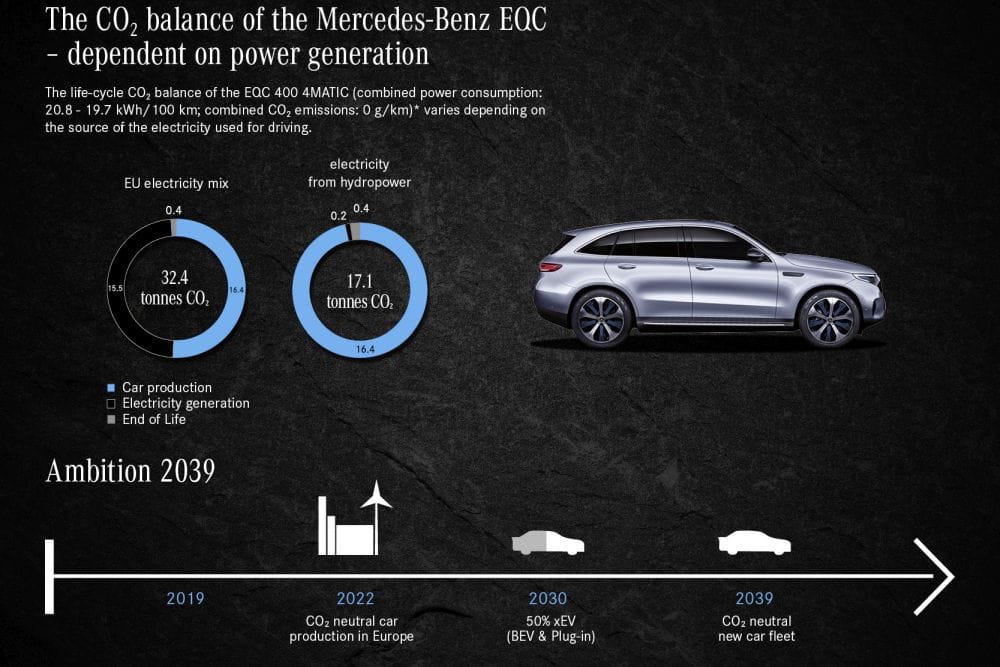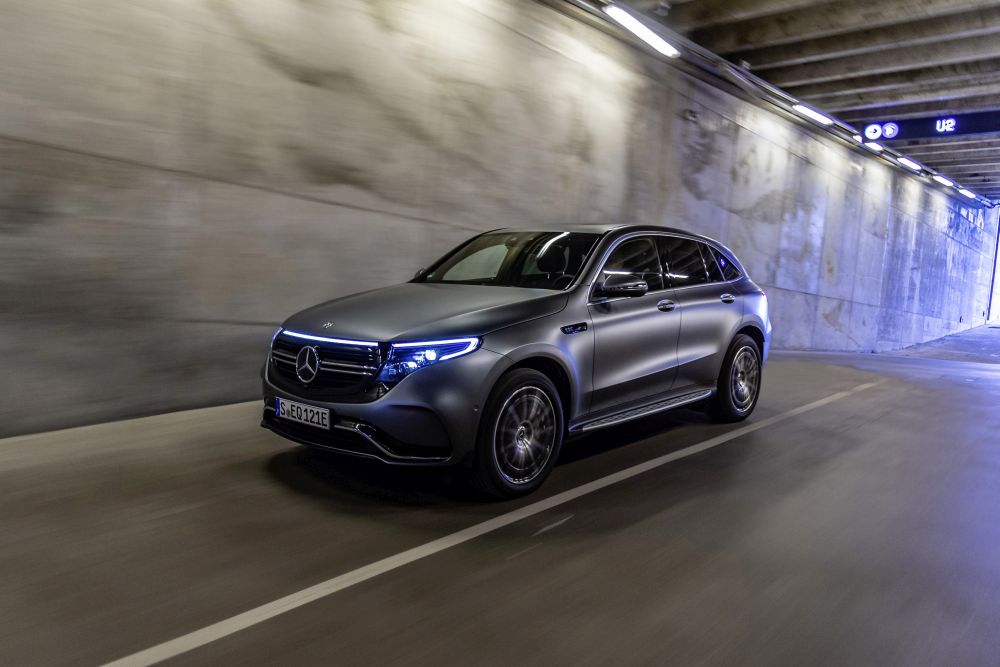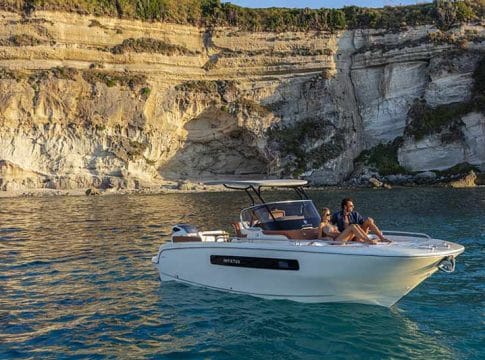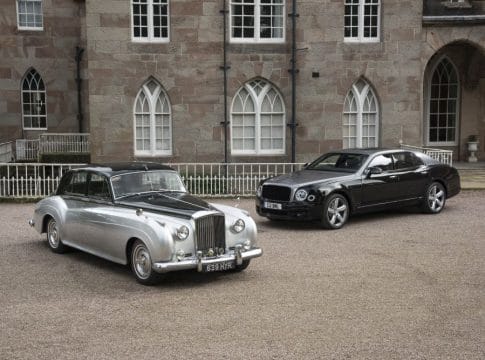Sustainability has many aspects. As a premium manufacturer, Mercedes-Benz strives to develop products that are particularly environmentally compatible in their market segment.
As part of the “Ambition 2039” vision, the aim of Mercedes-Benz for its passenger cars is to offer a CO2‑neutral new car fleet 20 years from now. With the Mercedes-Benz EQC 400 4MATIC, the company is bringing the first Mercedes-Benz vehicle to market under the product and technology brand EQ this year. This model has just successfully absolved the 360° environmental check. The results were comprehensively verified by TÜV Süd. The environmental check is based on an eco balance in which the environmental effects of the car are examined over the entire lifecycle, from the mining of raw materials to production and use, and eventual disposal. In this respect the EQC 400 4MATIC benefits from continuous locally emission-free operation and the high efficiency of the electric powertrain. What is also clear, however, is that the power mix for vehicle operation plays a particularly decisive role in the CO2 balance.
Only an assessment of the entire lifecycle of a vehicle provides a realistic picture of its CO2 footprint, for example. Mercedes-Benz has been regularly conducting this so-called environmental check, which takes all environmental aspects into account, since as early as 2005. The calculations are based on a driving distance of 150,000 to 300,000 kilometres, depending on the segment. In the case of the EQC this is 200,000 kilometres. During subsequent operation, and depending on their power source, electric vehicles can compensate the initially higher CO2 emissions that occur during production. If one is able to operate electric vehicles only with renewable energy sources, the CO2 emissions compared to those of vehicles with combustion engines shrink by up to 70 percent over the lifecycle.
Aim: CO2-neutral ex factory
Under what are otherwise the same conditions, more CO2 is generated during the production of an electric vehicle compared with a conventional vehicle, as battery cell production in particular requires a great deal of energy. This makes it all the more important to procure CO2-neutral energy for production in the future. Mercedes-Benz already plans to achieve this from 2022. All of the European plants are to have CO2-neutral production by then. One step on the way in Germany is power from national wind farms, for which subsidies according to the Renewable Energy Law (EEG) cease after 2020. Mercedes-Benz is the first large industrial customer to purchase from this source. In this way the company is safeguarding the continued, long-term operation of north German windfarms. This green energy from the windfarms is to be used e.g. for EQC production at the Mercedes-Benz plant in Bremen, and for battery production at the location of Deutsche ACCUMOTIVE in Kamenz, Saxony. At the Bremen Customer Centre, the EQC is also charged with solar energy before handover to customers collecting their vehicles.
Full CO2-neutral speed ahead
In the case of electric vehicles, and mainly owing to the complexity of battery production, approx. 51 percent of the entire lifecycle CO2 emissions occur during the production phase. Another 49 percent or so is accounted for in the operating phase, therefore it is decisive where the energy is sourced when using EU power both in the production and use phase. Mercedes-Benz is aiming to achieve CO2-neutral production in its own European plants from 2022. During the operating phase, the driver can even already influence what the eco balance of the vehicle looks like – depending on the energy source used for recharging. The eco balance, and especially the CO2 balance, varies accordingly when examining the entire lifecycle of the Mercedes-Benz EQC with a mileage of 200,000 kilometres. At present, 16.4 tonnes of CO2 are emitted during its production. If its batteries are charged from the EU power mix, this adds a further 16 tonnes. All in all, the emitted quantity of CO2 is then 32.4 tonnes. However, if the power for recharging is obtained from renewable sources, only an additional 0.7 tonnes of CO2 is emitted over the lifecycle (car production, energy consumption in operation, end of life). The overall CO2 emissions are then 17.1 tonnes of CO2: by using clean energy to charge the batteries, the CO2 footprint of the EQC can be practically halved.
The CO2 balance during the lifecycle compared with the power sources for charging the battery
Similar factors play a role when examining the energy balance. This is because the efficiency of energy production varies greatly according to the primary energy source used. The use of energy resources changes accordingly. In this calculation, the energy production and thus primary energy demand for operating the vehicle varies (EU power mix and/or hydroelectric power), while in contrast the energy consumption for EQC production and end of life remains unchanged. Here too the result is similar: renewable energy during operation lowers the overall energy balance of the EQC from 722 to 478 gigajoules – i.e. an energy saving of around 34 percent.
Responsible resource utilisation: use of materials and recycling
However, the 360° environmental check is not only about CO2 emissions and energy requirements. In order to gauge a vehicle’s environmental compatibility, the experts consider all emissions and the use and consumption of resources over the entire lifecycle. In production, the drive components specific to the EQC require a greater use of material and energy resources compared to a conventionally powered vehicle. The proportion of steel and iron is reduced by the omission of a combustion engine and transmission plus their peripheral units. On the other hand, the proportion of polymers, light alloys and other metals is increased.

Composition of materials
The kerb weight of the EQC 400 4MATIC is 2420 kilograms. The largest proportion omitted is 39 percent for steel and iron, followed by light-alloys (23 percent) and polymers, i.e. plastics (18 percent). For this reason, one developmental focus is on further reducing the use of resources and the environmental impacts of the materials used. Compared to current electric and plug-in hybrid vehicles, Mercedes-Benz intends to reduce the use of primary resources in the powertrain and battery technology by 40 percent by 2030. To this end, the use of resource-saving materials such as recycled plastics and renewable raw materials in the vehicles is constantly being extended. As just one example, the high-quality “Response” upholstery fabric that has been newly developed for the EQC is made completely from recycled PET plastic bottles. Recycled plastic materials are likewise used in typical applications such as for the lining of the spare wheel recess or the covers for the underside of the engine compartment. Renewable raw materials such as hemp, kenaf, wool and paper are also used. Kenaf fibres are e.g. used for the lining of the load compartment, while a paper honeycomb is used within the load compartment floor. In the new EQC a total of 100 components plus small parts such as push studs, plastic nuts and cable fasteners with a total weight of 55.7 kilograms can be produced partially from resource-friendly materials.
Second life for high-voltage batteries
During the development of a Mercedes-Benz vehicle, a concept is produced for each model in which all components and materials are analysed to establish their suitability for the different stages of the recycling process. Accordingly, all Mercedes-Benz car model materials are 85% recyclable and 95% reusable according to ISO 22 628. Including the Mercedes-Benz EQC. However, recycling does not primarily mean returning materials to the materials circuit. To implement the corresponding process chain and safeguard future raw material demand for electric mobility, the company is actively involved in the research and development of new recycling technologies. It has already been possible to gain insights into the recycling of lithium-ion batteries in a number of different research projects, and in collaboration with suppliers and waste-disposal partners. Recycling of the raw materials used such as lithium, nickel, platinum, cobalt and rare earths is an integral part of the considerations right from the moment the components are conceived. Mercedes-Benz has therefore defined four stages for battery recycling, and developed corresponding processes:
Re-use: Battery reuse: Here the reprocessing is limited to cleaning work and exchanging parts that have a limited useful life, e.g. fuses.
RePair: This more in-depth repair stage also includes repair work on the battery. In this way individual modules of the battery system can be replaced.
ReManufacturing: This process includes completely dismantling the battery into its component parts. After sorting and checking these parts and exchanging components where necessary, the battery system can be rebuilt.
ReMat: This process comprises recycling and recovery of valuable content materials. For the product recycling of high-voltage batteries, the company has already set up a central reclamation unit at the Mannheim site.
With respect to “ReUse” in particular, Daimler has focussed on stationary energy storage devices with the establishment of its wholly owned subsidiary Mercedes-Benz Energy GmbH: because the lifecycle of a plug-in or electric-vehicle battery does not have to end after it has done its duty in the vehicle, as it can be reused for stationary energy storage units. Stationary applications are not susceptible to minor power losses, which means that economical stationary operation is possible for at least ten more years, it is estimated. Reusing the lithium-ion modules in this way almost doubles their economical usage. The first second-life battery storage system was launched in October 2016 at the main REMONDIS site in the Westphalian town of Lünen.
Mercedes-Benz EQC 400 4MATIC: Electric Intelligence
The new Mercedes-Benz EQC systematically embodies the principle of “human-centred innovation”, and makes e-mobility simple, reliable and convenient for the customer. The power consumption and range of electric vehicles greatly depend on the driving style. The EQC supports its driver with driving modes that have different characteristics. The highlight of the new MAX RANGE driving mode is the haptic accelerator pedal, which assists the driver to drive economically. The driver is also able to influence the recuperation level using so-called paddles behind the steering wheel. Predictive driving for economy: in implementing this effective efficiency strategy, the assistance system ECO Assist comprehensively supports the driver by giving prompts when it is appropriate to come off the accelerator, e.g. because the vehicle is approaching a speed limit, and by functions such as ‘gliding’ and specific control of recuperation. For this purpose, navigation data, traffic sign recognition and information from the intelligent safety assistants (radar and stereo camera) are linked and processed. The EQC has a compact electric drivetrain at each axle, giving the vehicle the driving characteristics of an all-wheel drive. The asynchronous motors have a combined maximum output of 300 kW. The centrepiece of the Mercedes-Benz EQC is the lithium-ion battery arranged in the vehicle floor. With an energy content of 80 kWh (NEDC), it employs a sophisticated operating strategy to supply the vehicle with power, enabling an electric range of 445 – 471 km (NEDC).





